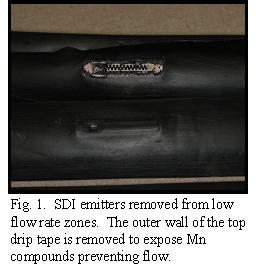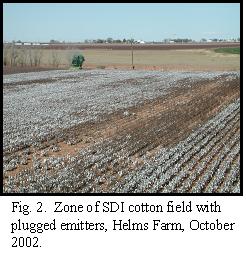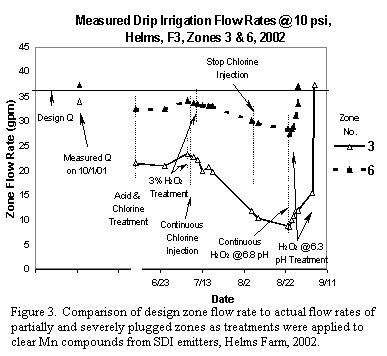(Field 3)
James P. Bordovsky and Joe Mustian
 Objective: The objective was to develop a method that prevents the deposition of manganese (Mn) compounds in SDI drip emitters and to reestablish uniform flow in SDI zones plugged by Mn.
Objective: The objective was to develop a method that prevents the deposition of manganese (Mn) compounds in SDI drip emitters and to reestablish uniform flow in SDI zones plugged by Mn.
Methodology: Deposits of manganese (Mn) compounds caused by Mn bacteria in the well water were plugging drip emitters and causing severe plant stress within SDI zones. The bacteria Crenothix and Leptpthix can oxidize dissolved Mn causing precipitation of manganese hydroxide. The most common approach to control Mn bacteria is by elevating the chlorine level in the well to between 400 and 500 ppm for up to 8 hours, then pumping the well to waste until the well water clears. Various attempts to unplug drip emitters in the lab and field using different types and concentrations of acids, hydrogen peroxide (H2O2), and chlorine were tried with no success. A method used to extract Mn from soil was modified and successfully used on plugged drip zones. The method involved injecting H2O2 into buffered irrigation water (pH < 7.0) and temporarily elevating the operating pressure on the drip system.
 Results: Shock treatment of water well with chlorine temporarily reduced the Mn slimes causing the emitter plugging problems. Treatment with H2O2 in buffered irrigation water increased flow rates in the most severely plugged SDI zones from 30 to 100% of the design flow rate. The risks associated with using the described unplugging procedure are unknown. The chemicals used are extremely hazardous. In addition, the effects of these materials on equipment and growing crops have not been sufficiently investigated. If deemed necessary, use of these procedures should be left to certified SDI consultants.
Results: Shock treatment of water well with chlorine temporarily reduced the Mn slimes causing the emitter plugging problems. Treatment with H2O2 in buffered irrigation water increased flow rates in the most severely plugged SDI zones from 30 to 100% of the design flow rate. The risks associated with using the described unplugging procedure are unknown. The chemicals used are extremely hazardous. In addition, the effects of these materials on equipment and growing crops have not been sufficiently investigated. If deemed necessary, use of these procedures should be left to certified SDI consultants.


